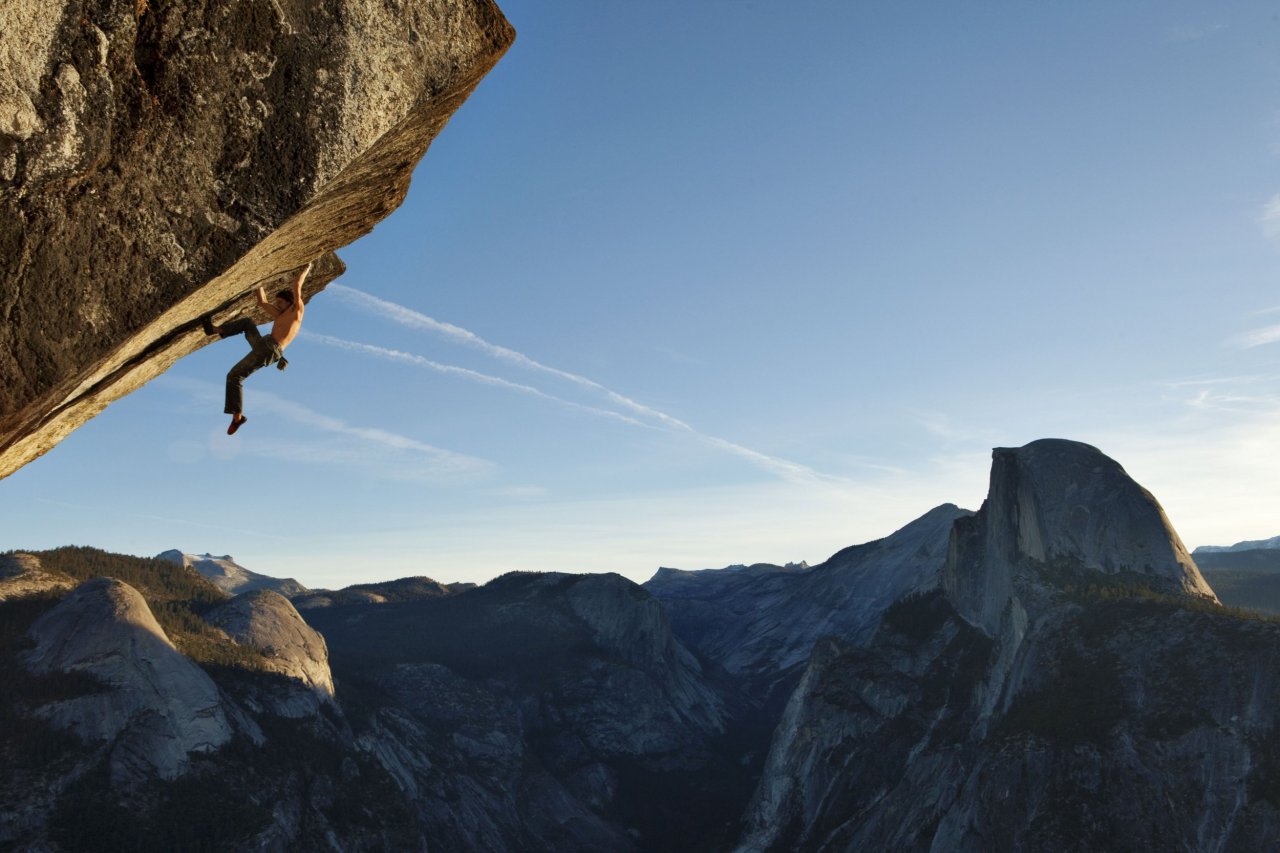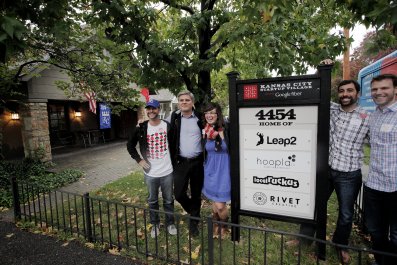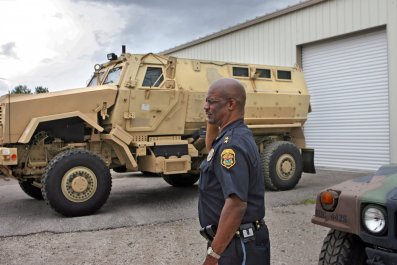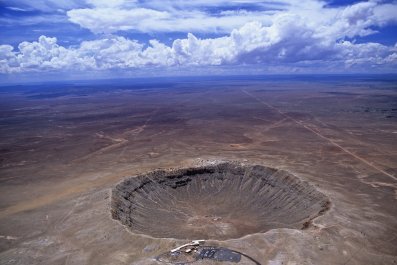"I want to fly."
Nine years ago, Dean Potter, then 34 and already the most transcendent figure of his generation in climbing, expressed that wish in an interview with Rock and Ice magazine. He was serious.
Potter had long since mastered the art of making molehills out of mountains: Cerro Torre and Fitz Roy in Patagonia; El Capitan and Half Dome in Yosemite National Park; the Eiger in Switzerland and the Delicate Arch in Utah. If there was a solid surface on the planet that required more than two limbs to clamber up, no one could do so more surely and swiftly than Potter.
At 6 foot 5, he stood head and shoulders above his mountaineering brethren in every way imaginable. He was a true rock god. An artist is how Potter thought of himself, not an athlete. These feats, these ephemeral acts of art that he performed with nature as his canvas, were about communion, not conquest. "The wilderness is infinite in what it offers," he said.
And thus, after a dozen years or so of handholds and footholds, Potter was jonesing to dabble in a new medium. "I want to fly."
Potter took up BASE (building, antenna, span, earth) jumping. Soon he had invented his own discipline, which he slyly named "freeBASEing." It entailed free climbing (no gear) and then leaping into the void before deploying a parachute. "I love the idea that I can change the worst possible thing to the best possible thing," Potter once said of freeBASEing. "Dying to flying."
He took up wingsuiting. In August 2009, Potter free-climbed (no gear) the Eiger and then propelled himself off its north face, setting a world record for the longest wingsuit flight (2 minutes, 50 seconds). The accompanying National Geographic video was titled "Fly or Die." Two years later, the National Geographic Channel aired a one-hour documentary about Potter and called it The Man Who Could Fly.
A visionary in his discipline, Potter had long defied the accepted paradigm of climbing. He was endeavoring to defy gravity. He even defied laws, when and if they impeded his artistic pursuits. "It's about basic freedom," he told National Geographic. "Being allowed to travel in nature in a way that doesn't harm the environment shouldn't be illegal."
"Dean Potter was an event," longtime climbing writer John Long told National Geographic a few weeks ago. "He was a force of nature."
Just before twilight on May 16, Potter, then 43, attempted an illegal BASE wingsuit jump from Taft Point, a perch located 3,000 feet above the Yosemite Valley floor. (BASE jumping is illegal in all national parks.) Accompanied by a friend, Potter hoped to glide through a V-shaped notch in an adjacent ridge before both he and Graham Hunt would deploy their parachutes. Potter had made dozens of similar jumps within Yosemite over the past half-decade without incident and, according to Yosemite Chief of Staff Mike Gauthier, at least 20 jumps from this perch.
"I've never had a close call," Potter told Rock and Ice last summer.
You can defy the laws of man indefinitely. But you can only defy the laws of nature for so long.
--------------------------------------------------------------------------------------------
"I do a lot of extreme speed flying, but wingsuits are where I draw the line," says Maxim de Jong. "Pretty much every climber that has taken up wingsuits is dead."
An aerospace engineer based in Chilliwack, British Columbia, de Jong understands both the principles and the pragmatics of flight better than most humans. The company he founded, Thin Red Line Aerospace, routinely solves aviation problems that are out of this world. "We're developing inflatable habitats for next-generation missions to Mars and Venus," he says. "Ninety-nine percent of our business is with NASA."
Last year, de Jong, 55, took on a project that was no less formidable: create a wingsuit that could land without its pilot having to deploy a parachute. Potter aspired to be that pilot. With financial assistance from a corporate sponsor, he enlisted de Jong and relocated to Chilliwack for the first half of 2014.
While de Jong relished the task from a technical aspect, he did not share Potter's romanticism. "If God meant you to fly, he'd have given you wings," de Jong would remind Potter. "Dean, you'reHomo sapiens."
While Potter cut a mythic figure, de Jong's adventures are also quite impressive. Two years ago, de Jong, a seasoned climber and fervent paraglider, set an unofficial world record for climbing the greatest vertical distance (26,000 feet) in one day. In a 21-hour span, he ascended Mount Cheam, a local 6,900-foot peak, four times, paragliding down to the bottom after each ascent. He ascended a vertical distance taller than Mount Everest.
Long before de Jong met Potter, he recalled having read about him. "This young kid shows up at King Tut [a 5.12-grade ascent just south of Salt Lake City] in the early '90s," says de Jong. "He on-sights it"—there was no previously mapped-out course—"and free-climbs it with ice in the cracks. That's insane. I read that and thought to myself, This is another guy who's got an 80 percent chance of being dead in three years."
What began as a wary collaboration blossomed into a friendship, however. Eventually it evolved into a big brother-little brother relationship between a pair of altitude-obsessed alpha males. "I loved Dean; my wife said that we were two peas in a pod," says de Jong, who has two sons. "She told me, 'Dean's probably the first real friend you ever had.'"
Potter had dropped out of the University of New Hampshire after three semesters and headed directly to Yosemite. More than a dozen years earlier, de Jong had quit medical school after one year in his native Belgium and purchased a one-way ticket to western Canada. Two peas in a pod, with one significant difference: One of them was a pragmatist. "Dean was very emotional about flying, like he was everything else," says de Jong. "He wanted to feel that connection to the natural world, which from my engineering perspective is bullshit. Man wasn't meant to act like a raven—land on a rock, pick at a deer carcass. But Dean was enthralled by those ideas."
De Jong taught Potter how to paraglide, but he had no interest in donning the flying apparatus he had designed for him. "A wingsuit isn't like a paraglider wing," says de Jong. "It's the equivalent of a sheet of plywood flying off a cliff."
Last June they took the wingsuit out for a test jump from a plane. Potter leaped from an altitude of 12,000 feet, and, according to de Jong, "Dean spent as much time as he could before the stall," i.e., before he was forced to pull his ripcord.
Potter only made one test flight with his new suit.
--------------------------------------------------------------------------------------------
In 1904, Scottish playwright J.M. Barrie introduced a beguiling and magical character to the world: Peter Pan. There are three items without which any description of Peter Pan is incomplete: 1) he can fly, 2) he never grows up and 3) he is fictional.
The popular stage play Peter Pan; or, the Boy Who Wouldn't Grow Up, was still running in London eight years later when a 33-year-old tailor named Franz Reichelt leaped off the first platform of the Eiffel Tower in a wingsuit he had designed himself. The "Flying Tailor," as Reichert was known, plummeted headfirst into the ground below, becoming the first modern-age wingsuit fatality.
In the past quarter-century, BASE jumping, in which practitioners leap from a fixed position before deploying a parachute, has become de rigueur among adrenaline fiends. But as dangerous as BASE jumping may be, it is merely a gateway drug to BASE jump wingsuit flying. BASE jumpers plummet straight down like suicide leapers before deploying their parachutes. Wingsuiters travel diagonally, covering two feet of horizontal distance for every one foot they descend while hitting speeds of 120 mph. It feels like flying. Almost.
In 2003, Dwain Weston, an Australian wingsuiter and BASE jumper who one year earlier had won the world title in BASE jumping, plowed into the Royal Gorge Bridge in Colorado. Weston, who was 30, had made more than 1,200 BASE jumps without incident. But it only takes one.
If Potter had an artistic credo, it was "Go toward your fears." He had dreamt of falling to his death as a child. His most superhuman trait may not have been the relative ease with which he scaled peaks or leaped off them but rather the fact that almost daily he confronted his greatest fear head-on. And yet, Potter never thought of himself as reckless. "I'm more proud of how many times I haven't jumped than how many times I have jumped," he told SI.com last summer. "Sometimes walking down, I've saved my life."
"Wingsuit BASE jumping feels safe to me," Potter wrote on his blog last year after the death of his close friend Sean Leary in Utah's Zion National Park, "but 25 wingsuit fliers have lost their lives this year alone. There must be some flaw in our system, a lethal secret beyond my comprehension."
On May 16, Dean Potter and Hunt leaped from a perch high above the Yosemite Valley floor and into Neverland. Footage from Potter's helmet-mounted GoPro appears to show that Hunt struck the side of the notch first and Potter, possibly attempting an evasive maneuver, struck rocks on the opposite side of the notch moments later. Their bodies were found 50 yards apart. Neither parachute had been deployed.
Dean Potter was 43 years old. He died of natural causes.
















